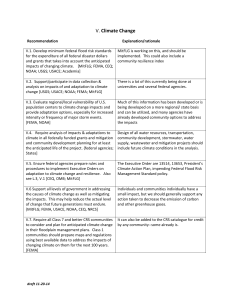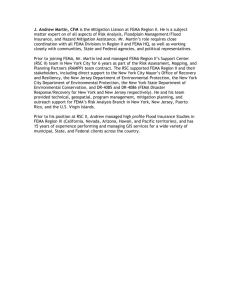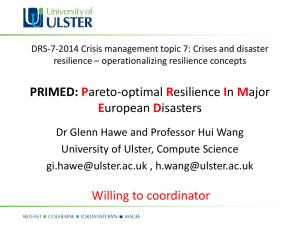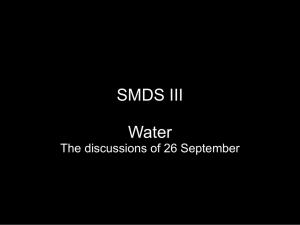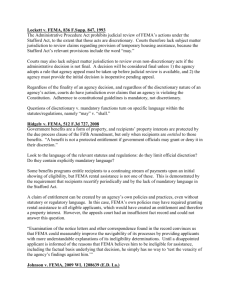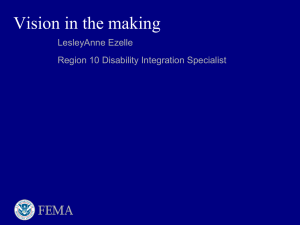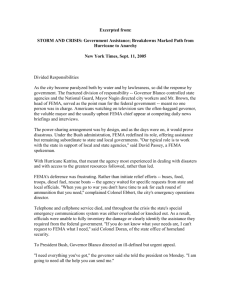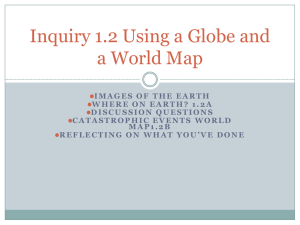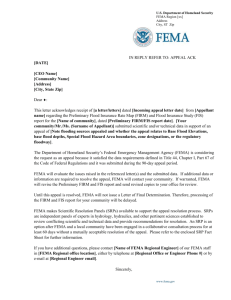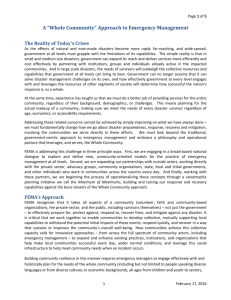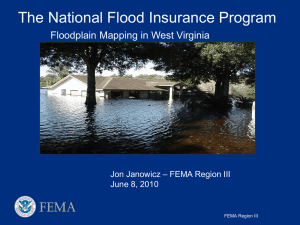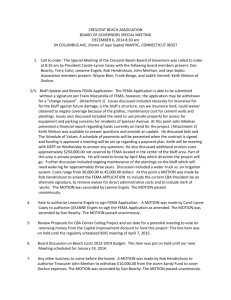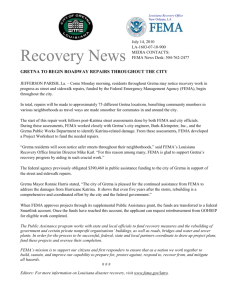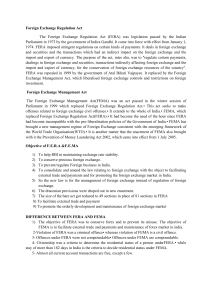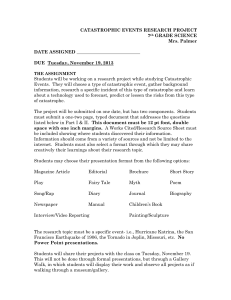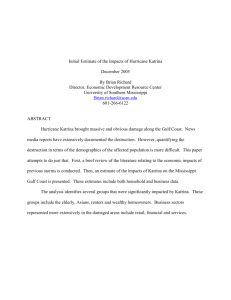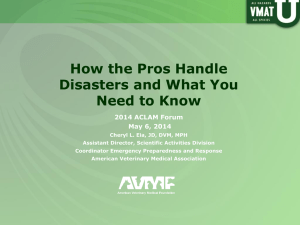Presentation by Michael Gresalfi
advertisement
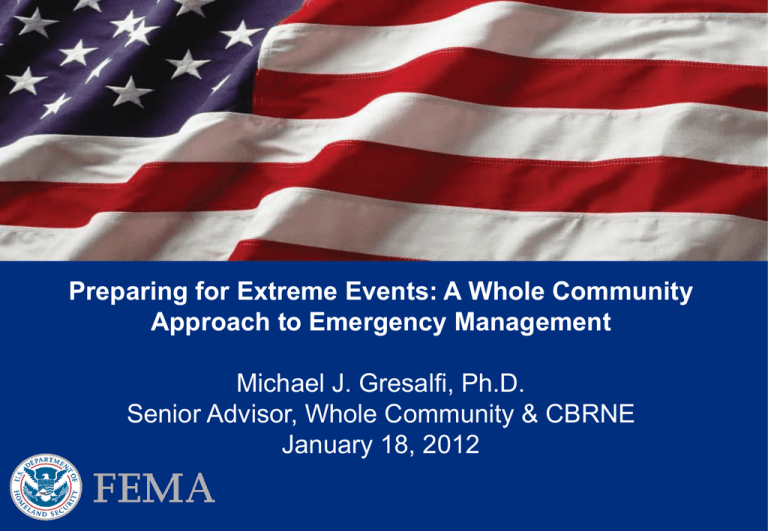
Preparing for Extreme Events: A Whole Community Approach to Emergency Management Michael J. Gresalfi, Ph.D. Senior Advisor, Whole Community & CBRNE January 18, 2012 0 Whole Community: A Philosophy for Emergency Management To meet existing challenges in the emergency management environment, government is moving towards a philosophy that builds upon the strengths of public partners and local communities: an effort FEMA refers to as Whole Community The focus of Whole Community is to foster development of a community-oriented model for emergency management that increases the resilience of communities – Resilience refers to the ability to adapt to changing conditions and to withstand and rapidly recover from disruption due to emergencies The Whole Community philosophy is based on three principles: WHOLE COMMUNITY PRINCIPLES Understand and meet the actual needs of the whole community Engage all aspects of the community to define and address essential life-saving and sustaining needs Strengthen community assets, institutions and social processes that work well in communities on a daily basis The Emergency Management Environment The environment for conducting emergency management is continuously evolving and presents new challenges as a result of greater interdependencies FEMA’s Strategic Plan refers to nine unique “drivers of change” that will both impact the global strategic environment and likely result in various emergency management challenges Drivers of Change 1. Changing Role of the Individual 2. Changing Climate 3. Aging Infrastructure 4. Evolving Terrorist Threats 5. Global Interdependencies 6. Government Budgets 7. Technical Dependencies 8. Universal Access to Information 9. Demographic Shifts Emergency Management Challenges Government at all levels has limited capabilities to manage disasters and cannot solve existing disaster management challenges on its own In large scale disasters, the needs of survivors will likely outweigh the collective resources contributed by government at all levels The present emergency management system is not designed to effectively support all phases of large and/or complex multi-state catastrophes Community Involvement is Essential During Extreme Events Extreme “catastrophic” incidents require a much broader set of partners within the impact area to accomplish response core capabilities than those routinely addressed for disasters we anticipate and plan for. Community involvement is needed to provide life saving and sustaining support to emergency response personnel , either as the primary or back-up source of manpower in the first hours and days following a catastrophic incident. Legal, policy, and regulatory waivers/exemptions/exceptions will be required to achieve the response “core capabilities”. The Meta-Scenario In order to anticipate catastrophic requirements and to avoid narrow focus on a limited number of specific scenarios, the Whole Community methodology is built upon a foundation of a meta-scenario consisting of the maximum of maximum challenges across a range of scenarios No-notice event Impact area – ~7 million population – 25,000 square miles – Several states and FEMA regions 190,000 fatalities in initial hours 265,000 citizens require emergency medical attention Severe damage to critical infrastructure and key resources Severe damage to essential transportation infrastructure – Ingress/egress options limited A Re-Cap of the Whole Community Initiative Whole Community “Meta-Scenario” Developed Response Core Capabilities Identified Objectives, Tasks, and Goals of each Core Capability Identified Emergency Support Leadership Group (ESFLG) Engaged Whole Community Steering Committee Established ESFLG Whole Community Working Group Formed 13 Core Capabilities and 4 Cross- Cutting Working Groups Stood Up (850 people) Information Analysis and Courses of Action (COAs) Completed (Draft) NLE 2011 conducted with injects to challenge Whole Community Approach FEMA Strategic Plan highlights Catastrophic Preparedness Key Initiatives Presidential Policy Directive #8 (PPD-8) Incorporates Whole Community Approach 5 Whole Community: Advantages The Whole Community approach to emergency management is vital to keeping public partners and communities safe, and to preventing the loss of life and property when disasters strike Adopting a Whole Community philosophy presents a number of advantages Advantages of a Whole Community Philosophy 1. Creates more capable, adaptive, and resilient communities by engaging and incorporating all community members into emergency management 2. Enables the delivery of services more efficiently by partnering with groups and individuals active in the impacted communities 3. Ensures disasters will be managed more effectively by leveraging resources from all segments of society “A Whole Community model that works to strengthen local collective action, public engagement, and neighborhood institutions offers an effective path not only to building resilience, but to helping local communities become integral members of the emergency management team” - FEMA Strategic Plan FY 2011-2014 Whole Community and PPD-8: Moving Forward In Tandem • Working primarily through our Regions, fully engage all elements of communities (large and small) and increase involvement and shared ownership in moving WC principles into practice. • Fully integrate policy, external affairs, response, recovery, mitigation and others at HQ and across the regions, in fostering a WC approach to emergency management. • Build the nation’s capacity to respond to, stabilize and recover from a catastrophic event, by first assessing, identifying, and then closing response and recovery deltas associated with WC/PPD-8 response core capabilities. • Together the WC Steering Committee and FEMA’s Regional Administrators provide leadership in meeting Whole Community and PPD-8 critical objectives and outcomes. Your Guidance and Advice Is Requested How might attract new community-level partners in closing core capability gaps, and identifying innovative solutions? How might we better understand the current state of community resilience, and how to advance such resilience? How might we identify emergency response best practices across the nation, and then foster mentor-protégé’s links? Michael Gresalfi, Ph.D., Senior Advisor for Whole Community and CBRNE 202-302-5179 Michael.Gresalfi@dhs.gov 8
